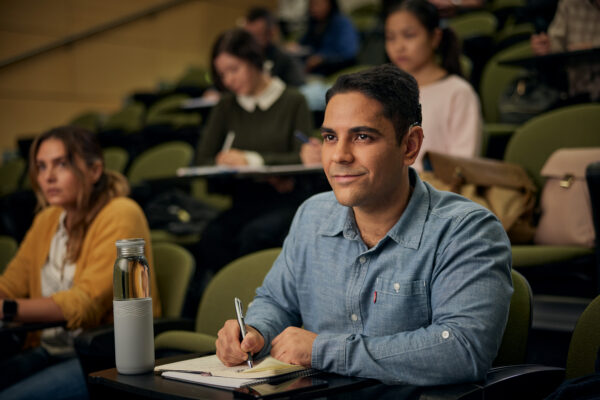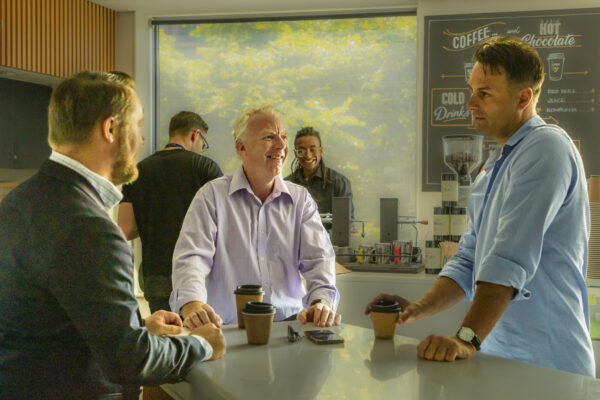Do you sometimes feel tired, frustrated, or overwhelmed after listening for a long period of time? Or maybe you zone out, lose focus, or miss important details during conversations? If you answered yes to any of these questions, we can help you navigate listening fatigue.
Feeling tired and stressed from listening is real. You must focus harder than your hearing peers just to hear and communicate.
Listening fatigue is commonly reported by recipients. It happens when the brain gets tired from focusing on listening, especially in difficult situations such as noisy places, group conversations, or virtual meetings.
Beyond tiredness, it can affect your mood, concentration, productivity, and social interactions. That’s why it’s important to recognize the signs and learn ways to cope with it.
“It’s very normal to feel tired after a full day of listening, especially in the early days after activation. You’re not alone. Be kind to yourself and find something to help wind down after the day is over. Having a short break from your sound processor is fine, especially if it gives you the energy to get through the day when you put it back on.” – Jen C, Clinical Audiologist at Cochlear
Many different factors impact listening effort, such as noise around you, how tired you were when the day started, the difficulty or your familiarity with the information being presented, and so on.
Here are some tips to help you manage listening fatigue.
Know your triggers
One of the challenges of listening fatigue is identifying your triggers. Think about what situations cause you to fatigue and how can you manage them. Some people tell us they plan their day to avoid overloading it with challenging situations and environments, especially around holiday periods.
Filter out background noise
A top cause of listening fatigue is background noise, which makes it harder to hear and understand speech.
Nomiki has a cochlear implant and volunteers for a support group for teens with cochlear implants. She suggests changing your sound processor settings. She uses the Nucleus® Smart App1
to adjust the settings to help with certain listening environments.
“I change the settings on the app by having it on ‘Restaurant’ mode and also use ForwardFocus2 to reduce as much background noise as possible. This can reduce fatigue as you don’t need to exert that effort to filter speech from noise.”
ForwardFocus is a feature of Nucleus® Nexa™ sound processors that reduces background noise to help focus on face-to-face conversations, and can be automated or switched on and off using the Nucleus Smart App.
Know where to sit in restaurants and cafés
“Another tip at restaurants would be to sit with your back against the crowd, rather than sitting against the wall. This is a tip from my audiologist as the sound processors will be picking noises from the front [when ForwardFocus is enabled]. Also, moving to a quieter part of the room (even outside) can help significantly, with the bonus of fresh air,” says Nomiki.
Let others know you have hearing loss
Sometimes the stress or anxiety of trying to understand what people are saying can cause listening fatigue, especially if they have unfamiliar accents, speak fast, or are softspoken. Nomiki explains her situation to new people she meets and asks for clarification or repetition if needed.
“It’s completely up to you whether you want to disclose it”, she says. “Sometimes, I like to explain, especially if I am really struggling to understand the person, so it prevents any misunderstandings.
“Group situations can be tricky. Having someone you trust helps in that they can relay the information to you afterwards.”
Find strategies for video calls
Virtual calls and meetings can be exhausting as they require greater concentration and attention.
For Katie, a cochlear implant recipient who works remotely, getting ready for a day of video conferencing “feels like preparing to ride a bike uphill through peanut butter”.
“I have access to captions and streaming, but when I’m participating in group conversations, I am routinely off pace from everyone else—it’s too fast and unpredictable,” she says, adding that by the end of the day she is exhausted.
While many video calling platforms, such as Microsoft Teams® and Zoom® offer captions and transcriptions for live videos, we know that there can still be a lag in the timing. You can also try an automatic web-based speech recognition tool to provide captioning for virtual meetings. Web Captioner® ® are web-based services that can be used in conjunction with your video conferencing app. Reviewing a transcription after the call can also be beneficial.
Nomiki finds taking breaks helps. “Some of my friends like to take breaks in between meetings. For me personally, I prefer to take two to five minutes (time permitting) in between meetings, and I like them to be in a block (say, all meetings in the afternoon). Then I can have a proper 30-minute break where I can relax my mind and refocus onto the next thing.”
Look after your physical and mental health
“Coming from a deaf or hard-of-hearing perspective, we exert more effort and can tire out quickly throughout the day,” Nomiki says. She recommends doing something you enjoy and find therapeutic.
“For me it’s going for a swim, where I can switch off. Getting exercise in the morning has helped me so much. By getting some movement in first thing in the morning, it boosts my mood and energy level.”
Connect with support groups
Finally, one of the best ways to deal with listening fatigue is to connect with the deaf community and support groups where you have the chance to share experiences, tips and learn from each other.
“I joined Hear for You as a mentor to give back to the community. Little did I know how impactful it was to my own life even. I made friends with the mentors, and we love to share tips and tricks to going about things. For me, it’s so much more fun to help others, and be on this journey together.”
For more suggestions and listening practice, visit our website.
- The Cochlear Nucleus Smart App is available on App Store and Google Play. For compatibility information visit www.cochlear.com/compatibility.
- ForwardFocus can only be enabled by a hearing implant specialist. It should only be activated for users 12 years and older who are able to reliably provide feedback on sound quality and understand how to use the feature when moving to different or changing environments. It may be possible to have decreased speech understanding when using ForwardFocus in a quiet environment.

